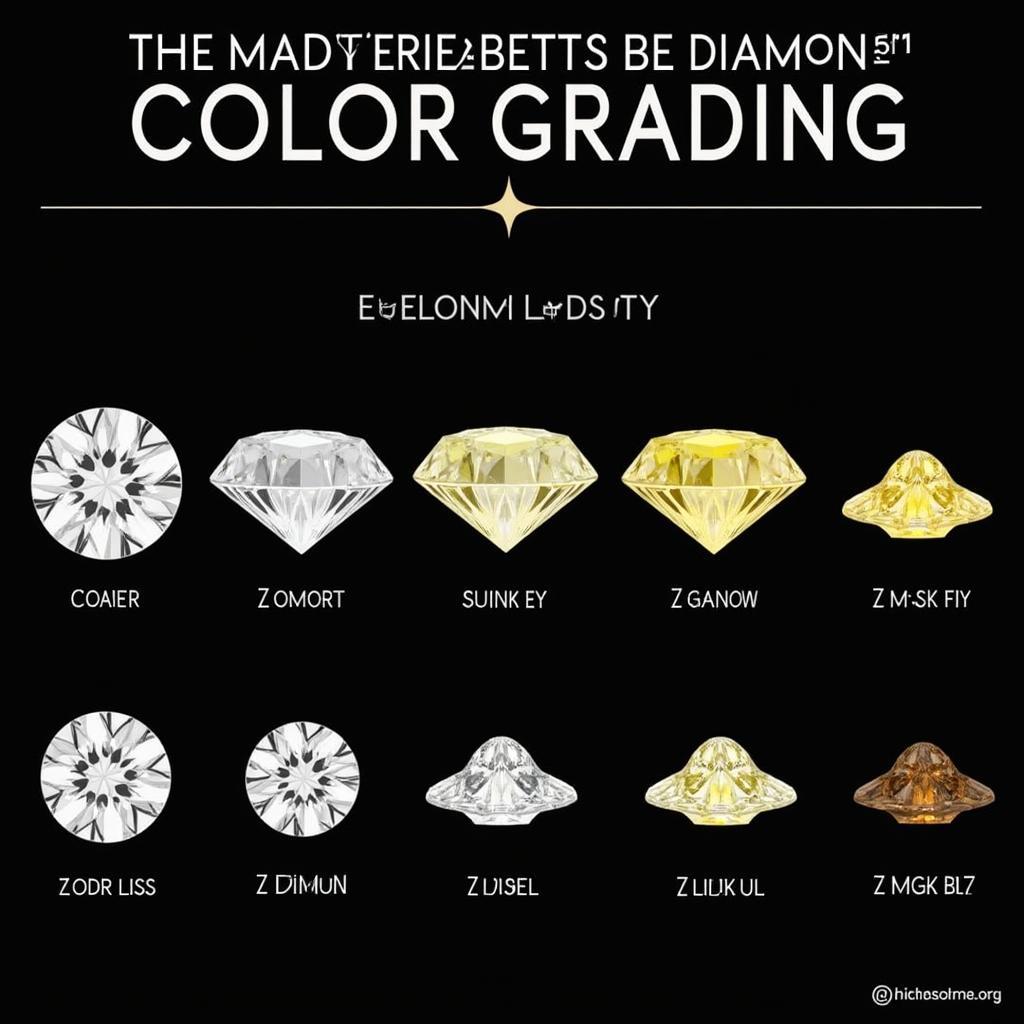Diamond white, a term often used to describe the color of diamonds, can be a bit misleading. While we picture “white” as pure and devoid of color, diamonds graded as white actually possess subtle undertones that affect their appearance. Understanding what constitutes “diamond white” is crucial when selecting a diamond, as these subtle variations influence brilliance and value. Let’s dive into the fascinating world of diamond color and explore the nuances of “diamond white.” Just after understanding natural diamond colors, you might be interested to find out more about Tanzanite and its unique color. what color is tanzanite
Decoding Diamond White: Beyond the Name
The Gemological Institute of America (GIA) uses an alphabetical scale, from D to Z, to grade diamond color. D represents the most colorless, and therefore most valuable, while Z indicates a noticeable light yellow or brown tint. Diamonds graded D, E, and F are considered “colorless,” exhibiting minimal to no color. These are often referred to as “diamond white.” However, even within this colorless range, subtle variations exist. D is truly exceptional, exhibiting an icy white sparkle. E and F are close behind, showcasing a near-colorless appearance that is still highly prized.
What Makes a Diamond Appear White?
A diamond’s whiteness is determined by its ability to absorb and reflect light. The fewer impurities and imperfections present in the diamond’s crystal structure, the more light it can reflect, giving it a whiter appearance. This is why diamonds with higher color grades are more brilliant and sparkle more intensely. They allow light to pass through unimpeded, creating a dazzling display of light and color.
The presence of nitrogen within a diamond’s structure is the main factor that determines its color. For colorless diamonds, lower levels of nitrogen means that the stone is practically clear of any noticeable yellow tint.
 Diamond Color Grading Scale D-Z
Diamond Color Grading Scale D-Z
Beyond Colorless: Near-Colorless Diamonds (G-H-I-J)
Diamonds graded G, H, I, and J are considered “near-colorless.” While they may possess a slight tint of yellow, it is often so subtle that it’s difficult to detect with the untrained eye. These diamonds offer an excellent balance of beauty and value, as they exhibit near-colorless sparkle at a more affordable price point. Are you curious about canary color? You can find more information here. what is canary color
Can Diamond Color Change Over Time?
No, a diamond’s color grade is permanent and does not change over time under normal wear and tear. The color is determined by the diamond’s inherent structure and cannot be altered by external factors.
“A diamond’s color, once graded, is a fixed characteristic,” says gemologist Dr. Anya Sharma, “It’s a fingerprint of its formation, a testament to the forces that created it deep within the earth.”
Factors Affecting the Perception of Diamond White
While the GIA color grade is the most reliable indicator of a diamond’s color, other factors can influence how we perceive its whiteness. These include the diamond’s cut, clarity, and setting.
How Cut, Clarity, and Setting Influence Color
A well-cut diamond reflects light optimally, maximizing its brilliance and masking any subtle color tints. Similarly, a diamond with high clarity allows light to pass through unimpeded, enhancing its whiteness. The setting metal can also influence color perception. White gold or platinum settings tend to enhance the whiteness of a diamond, while yellow gold can make slight tints appear more pronounced.
Understanding Natural Diamond Colors:
Natural diamonds come in a variety of colors. Have you ever wondered what colors are available naturally? Find out here. what colors do diamonds come in naturally You might also be interested in learning more about the color of natural diamonds. what color are natural diamonds
Conclusion
Diamond white is a complex term that encompasses a range of colors, from truly colorless to near-colorless. Understanding the GIA grading system and the factors influencing color perception empowers you to choose a diamond that aligns with your preferences and budget. Whether you opt for the icy brilliance of a D flawless diamond or the subtle warmth of a near-colorless stone, the beauty of “diamond white” lies in its subtle variations and enduring sparkle.
FAQ
- What is the whitest diamond color? D is the highest grade and represents the whitest color.
- Are diamond white and colorless the same? Generally, yes. D, E, and F are considered colorless and often referred to as diamond white.
- Does diamond color affect price? Yes, colorless diamonds are the most rare and therefore the most expensive.
- What is the best diamond color for an engagement ring? D-F are ideal, but G-J offer excellent value.
- Can I tell the difference between D and E color diamonds? It’s very difficult to distinguish with the untrained eye.
- What color diamonds look best in yellow gold? Near-colorless diamonds (G-J) often complement yellow gold well.
- Do all diamonds sparkle the same? No, cut, clarity, and color all influence a diamond’s sparkle.
Scenarios where “what color is diamond white” is commonly asked:
- At a jewelry store: Customers often ask this question when comparing diamonds and trying to understand the difference in color grades.
- Online research: Individuals researching diamonds online will frequently search for this term to gain a better understanding of diamond color.
- Discussions with friends/family: People may ask this question when discussing engagement rings or other diamond jewelry.
Related Questions and Further Reading:
You might also be interested in learning about the color of regulatory signs. Check out our article on what color are regulatory signs in sc.
Need Help Choosing the Perfect Diamond White?
Contact Color Box Hanoi today! Call us at 0373298888, email us at [email protected], or visit us at 86 Cầu Giấy, Hanoi. Our team is available 24/7 to answer your questions and guide you through the process of selecting the perfect diamond.